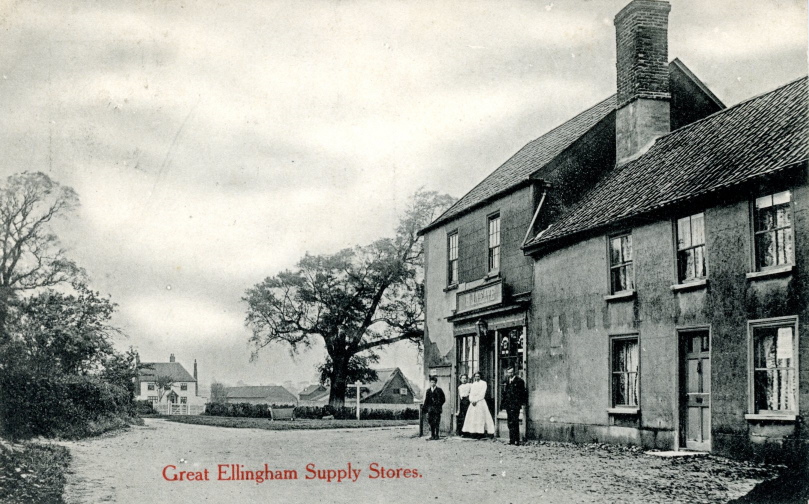
The above image may well have been captured at the turn of the 20th century.
The name ‘H J NEAVE’ can just be seen above the door of the shop. Perhaps the proprietor, Herbert Joseph Neave and his wife Mary, are amongst the four individuals standing outside the shop.
Some 100 years earlier, the Rose family owned the shop and adjacent house (also shown in the above image).
As far as I know, the house and the shop were in the same ownership (albeit different successive owners) from at least the time that the Rose family owned the premises (before 1800), until Ian and Anne Arundel purchased the premises in the 1970s.
Prior to Herbert Neave buying the premises in 1920, he rented the shop and house. Indeed the house and shop were tenanted from at least 1894. However from my local knowledge, I suspect that the shop and house were rented out and occupied by tenants from at least the 1870s.
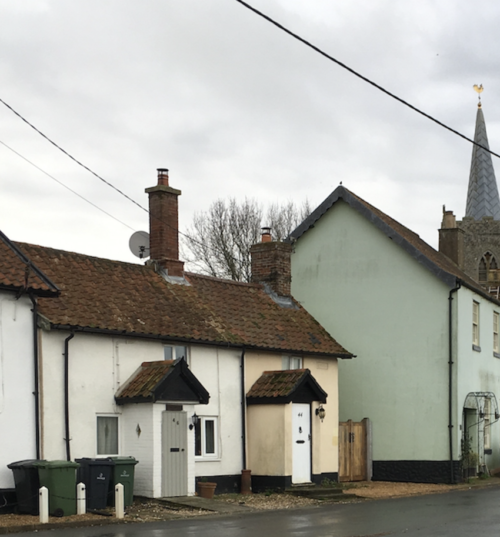
Church Street Cottages. Former shop to the right. Photograph taken February 2019
Further, I believe the shop was rebuilt around 1875. Accordingly, Rose’s original shop may have looked very different to Neave’s shop shown in the above postcard. I also believe that the two cottages to the north of the shop (pictured above) may well have been built at this time.

The house abutting the churchyard and adjacent to what once was the Supply Stores (on the left). Photograph taken July 2022
The house may well have undergone many changes too. It is also likely that the southern end of the house may have had a separate (but small) tenement. This small tenement may have been let separately.
In this blog, we look at the Neave family who occupied the shop and house from just before 1900, purchased the premises in 1920 and continued to own and occupy the premises until 1962.
Wymondham Born
Herbert Joseph Neave was born in Wymondham on the 25th September, 1873.
1881 census
The 1881 census captures 7 year old Herbert with his parents, James and Eliza Neave, and four of his siblings at Fairland Street, Wymondham. At 48, James Neave was an agricultural labourer.
1891 census
Ten years later, 17 year old Herbert Neave is with the household of his 28 year old brother James at the shop in Well Green Street, East Tuddenham.
The Neave household comprise grocer and draper James Neave, his 29 year old wife Anna E Neave and their children Albert 5, Kate 3 and three-month-old Bessie. Herbert is a grocer’s assistant – no doubt, working for his brother and ‘learning the trade’. The household also has a 16 year old general servant, Ada Fisher.
Marriage
In the late spring or early summer of 1895, Herbert married Florence Rolfe – probably in Brandon, Suffolk. Herbert – or, rather, Joe as he was known, may well have been living and working in Brandon at this time.
Their daughter, Mary Josephine, was born two years later in Brandon.
Move to Great Ellingham
In January 1900, Joe and Florence together with their young daughter Mary Josephine, came to Great Ellingham.
They rented premises comprising a shop and house from George Henry de la Cour. I feel certain that Joe and Florence Neave lived in the house adjacent to the shop.

Agreement dated 8 January 1900 between R Young and H J Neave for Joe Neave’s purchase of the Stock, Fixtures & Trade relating to the Supply Stores. Courtesy Cindy & David Dove
The outgoing tenant was ‘Mr R Young’. Joe Neave purchased the stock, fixtures and trade relating to the Supply Stores from Young for £138. £100 was paid on the 8 January with the balance to be paid within three months.
De la Cour
George de la Cour was not a local man. He was a jeweller of Chatham, Kent. He had purchased the premises (along with other property in Great Ellingham) from Walter Leeder in the May of 1894.
Leeder
Given that Walter Leeder’s father, Thomas Leeder, previously owned the other property in Great Ellingham, I have no doubt that Thomas Leeder was also the previous owner of these premises.
Indeed in 1875, Thomas Leeder advertised for tenders to be submitted to him for the erection of two cottages, shop and premises &c at Great Ellingham.
I think it more than possible that it was at this time that the shop was rebuilt, and the two cottages to the north of the shop, were built.
Death of Florence Neave
Sadly, Florence Neave died aged 34 on the 27th June, 1900.
Joe was left a widower with a three year old daughter. Perhaps it was at this time that Joe’s mother, Eliza, came to live with her son.
Neave’s Home ‘Unfit for Human Habitation’
I found reference a report given by Dr Foster, the Medical Officer of Health to the Wayland Rural District Council , in the Downham Market Gazette on Saturday 8th December, 1900. In his report, Dr Foster mentioned Joe Neave’s home in Great Ellingham:
“… He [Dr Foster] also certified a house in the occupation of J.H. [H.J.] Neave at Great Ellingham, to be unfit for human habitation…… The owners in the case of the house in Great Ellingham, occupied by Mr Neave, were notified to abate the nuisance existing…”
Unfortunately, no details of the ‘nuisance’ were reported by the newspaper.
Nevertheless, it seems that this was not the only house in Great Ellingham to come to the notice of the Medical Officer. The same report also mentions:
“…. A nuisance was reported at Great Ellingham on property owned by Lord Walsingham, and occupied by Bilverstone, in which the Council having given repeated notices to abate without avail, decided to take proceedings..”
Again with no details of the ‘nuisance’ given, we do not know what was cause of the ‘nuisance’ to warrant either property ‘unfit for human habitation’.
Amongst the provisions of the Housing of the Working Classes Act of 1890, enforcement powers were given to local authorities in relation to sanitary conditions and overcrowding in housing.
In the case of Joe Neave’s home, it was more likely to be the sanitary conditions of the property rather than overcrowding.
Living Conditions in the Village
Three years later, the Medical Officer reported on the living conditions of Robert Oldfield’s family occupying a cottage opposite Joe Neave’s home. In this case, details of the family’s living conditions were reported in a local newspaper.
Having found several references to the condition of some of the houses in the village around this time, I wonder just how many families were living in far from ideal conditions.
Repair
Nevertheless in the case of Neave’s home, the Downham Market Gazette of Saturday 19th January 1901 contained the findings of a recent meeting of the District Council.
Amongst the matters discussed was Joe Neave’s home. The clerk to the Council reported that:
“.. he had received a letter from Mr de la Cour, the owner of the house at Great Ellingham, occupied by Mr Neave (which had been condemned by the Medical Officer of Health), stating that the house in question should be put in a state of repair at once.”
The matter was held over for a month. However, I have yet to establish whether or not the matter was satisfactorily concluded.
1901 census
This census finds 27 year old widower Herbert J Neave with his 3 year old daughter Mary, his 70 year old widowed mother Eliza and their 21 year old servant, Mary Ducker, living in Church Street. Again I have no doubt that they were living in the house adjacent to the shop.
Further, there may well have been an additional (but very small) tenement with its own front door at the southern end of the house adjacent to the churchyard. This small tenement may have housed another individual or family.
Remarriage
In the latter part of 1910, Joe Neave married Mary Ann M Higgins. Born in Melbourn, Cambridgeshire, Mary was the daughter of Baptist Minister, William Higgins and his wife Emmeline.
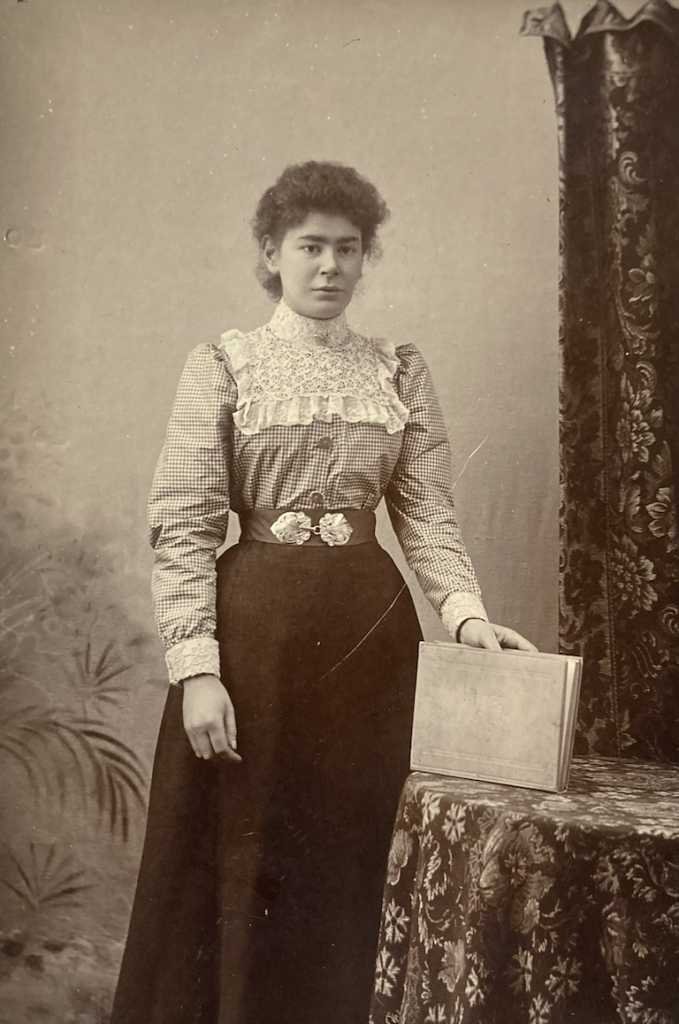
Mary Ann Higgins aged 21 years. Courtesy Cindy & David Dove
William Higgins was the Pastor at Great Ellingham Baptist Church from 1906 to 1912. Accordingly at the time of the marriage, William Higgins (then widowed) lived at the Manse in Long Street.
The 1911 census captures Mary’s sisters Alice (27) and Lavinia (21) with their father at the Manse. Given that Alice is described as a draper’s assistant, it would follow that Alice is working for Joe Neave at the Supply Stores in Church Street.

Could it be Alice with her sister Mary (along with Joe Neave and another) in the postcard?
Birth of a Son
On the 20th June, 1912, Joe and his wife Mary welcomed a son, Raymond Fuller Neave.
David Bugden’s informative book ‘The story of 300 years of the Baptist Church at Great Ellingham‘ suggests that Raymond was born ‘in a room above his parents’ grocery shop..’.
However given that the Neaves also occupied the house adjacent to the shop, Raymond may well have been born in the house.
Having said that, it was once possible to access the rooms above the shop from the house. Accordingly, it may be that Raymond was indeed born in a room above the shop!
Raymond was said to have been a ‘rather unhealthy infant’. At the age of 3, he developed pleurisy. His mother nursed him back to health.
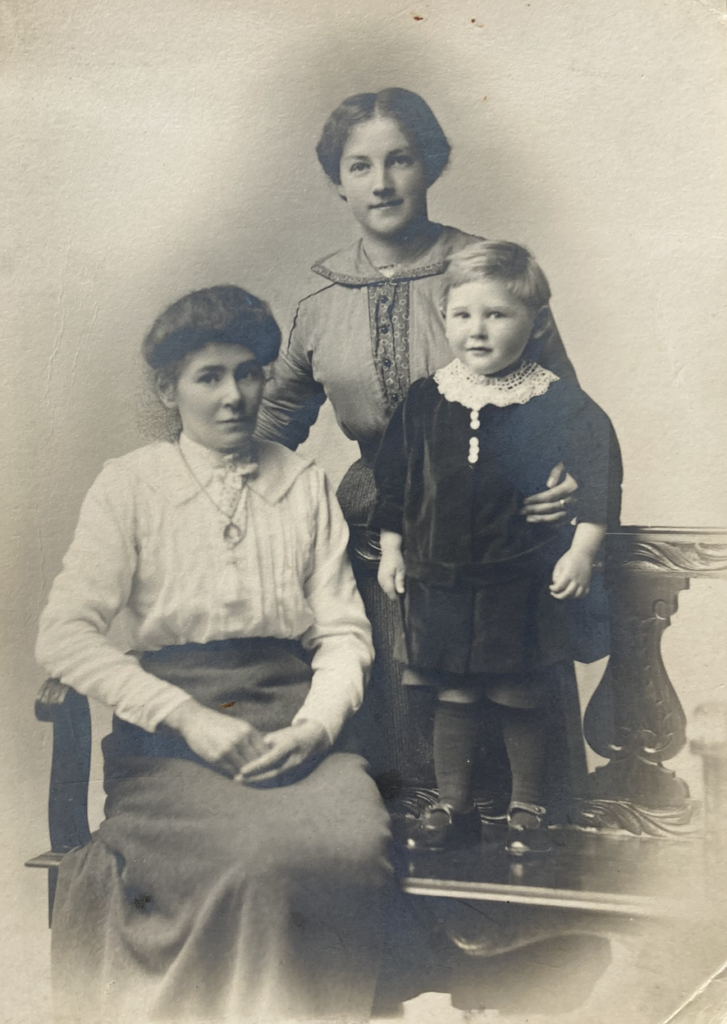
Young Raymond Neave (right) with his step-sister Mary Josephine (centre) and mother Mary Ann M Higgins (left). Courtesy Cindy & David Dove
Death of Owner, George de la Cour
Joe Neave’s landlord, George Henry de la Cour, died on the 10th December, 1914.
However it was not until 1920 that de la Cour’s surviving executor, Henry Allen, sold the Great Ellingham shop and house. This may well have been due to the conflict in Europe.
Accordingly, Joe Neave continued to rent the premises for de la Cour’s executor.
Joe Neave Buys his Shop and Premises
On the 17th July, 1920, Joe Neave purchased his shop from Henry George Allen of 76 High Street, Chatham. Allen was the surviving executor of the late George de la Cour who had owned the property from 1894 until his death in 1914.
For the sum of £300, Joe Neave purchased:
‘ALL THAT freehold dwelling house and shop with the warehouses, stable, gig house, shed, garden and outbuildings thereto belonging situate in Great Ellingham now in the occupation of the Purchaser bounded on the north by hereditaments now or late of Charles Adams on the east by the hereditaments now or late of W R Kybird on the south by the churchyard of Great Ellingham and west by the road known as Church Street or Church Gate..’
Given that Joe Neave purchased the shop and the adjacent house (which abutted the churchyard of St James), it follows the the Neave family lived in the house. As I mention, at one time the rooms above the shop could be accessed from the house.
Indeed, the shop and the house remained in the same ownership until the 1970s.
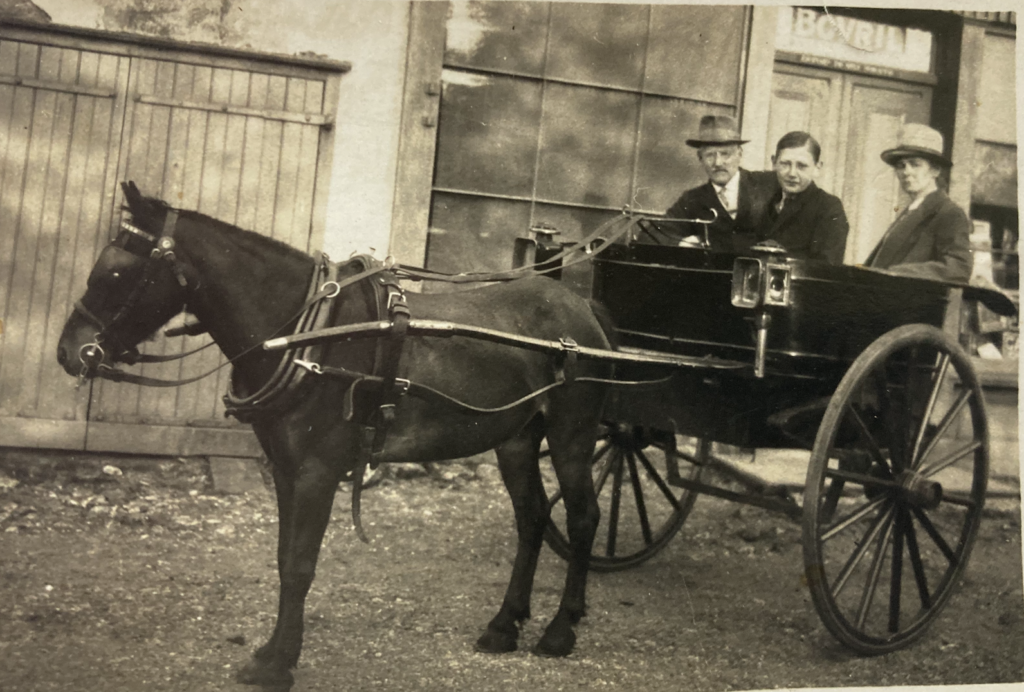
Joe Neave with son Ray and possibly his wife Mary Ann outside their Supply Stores in Church Street.
Courtesy Cindy & David Dove
1921
The national census of 1921 lists 47 year old Herbert Joseph Neave with his 42 year old wife Mary and their 9 year old son, Raymond Fuller Neave, in Church Street, Great Ellingham.
At this time, Joe’s daughter, Mary Josephine, was living in Brandon. Two years earlier, she had married Stanley Lingwood. Stanley was the owner of Brandon’s first cinema.
The census confirms that Raymond Neave was attending school full-time. Indeed, Raymond went to the Board School in Hingham Road. He finished his education at the age of 14.
Young Raymond Neave is possibly on the school photograph below.
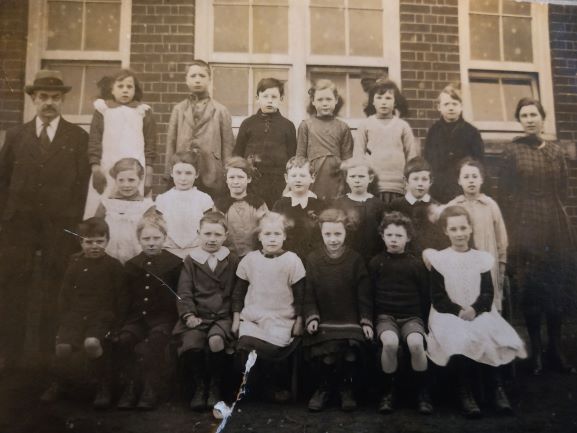
Great Ellingham School. Possibly early 1920s.
Mr Field Headmaster. Mrs Overton (nee Ethel Beales) Teacher. Children back row (next to Mr Field) Lily Key, unknown, unknown, Nelly Morter, possibly Josie Sadd, Claude Lebbell. Middle row (next to Mr Field) unknown, unknown, possible Molly Giles, possibly Ray Neave, possibly Myrtle Beales, Herbert Saunders, Lily Hammond. Front row (next to Mr Field) Falcon Lee Bilham, George Leverett, Lenny Bowen, Clementine Dorothy Wilkins Skipper, ? Harper, unknown, Olive Saunders.
Names as remembered by Herbert Skipper. Photograph courtesy Sarah Brand
I have no doubt that the Neave family contributed the village life. Joe Neave played cricket for the Great Ellingham Cricket team. Indeed he was also a member of the cricket committee.
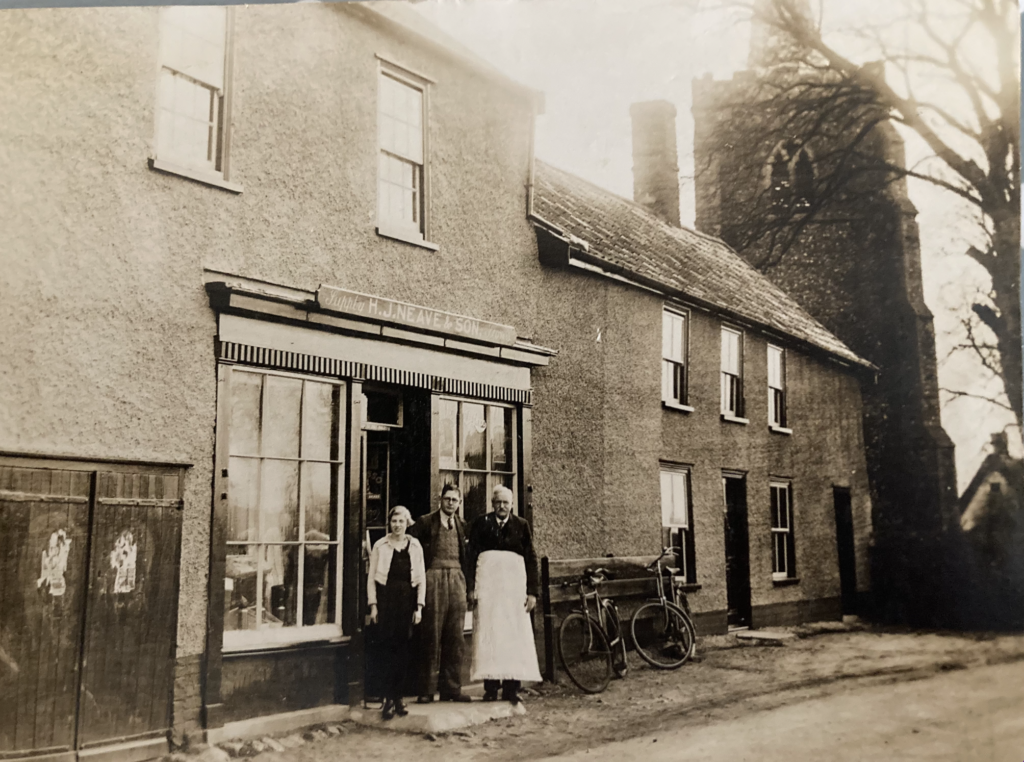
Raymond Neave (centre) with his father Joe (right) and possibly Ray’s step-sister Mary (left) outside their Supply Stores. Courtesy Cindy & David Dove
Baptist to Methodist
With his maternal grandfather William Higgins, a Baptist Minister, it is no surprise that the family attended the Baptist Church in Long Street.
However later in the 1920s there was some acrimony around the then Pastor at the Baptist Church, and the Neave family ‘came away’ from the Baptist Church. They began attending the village’s Methodist Church.
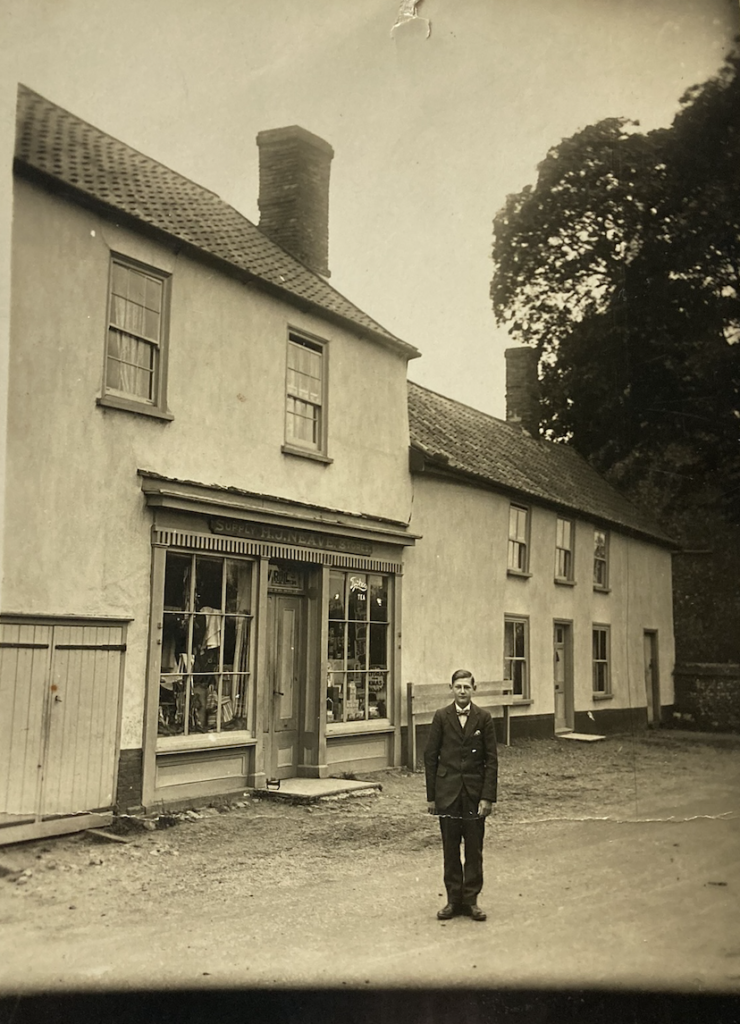
Raymond Neave outside his father’s supply stores ‘H J Neave’ above the door. c.1927. Courtesy Cindy & David Dove
Raymond Neave marries Evelyn Dove
The story goes that it was whilst the Neave family attended the local Methodist Church that Raymond met his future wife, local girl Evelyn Dove.
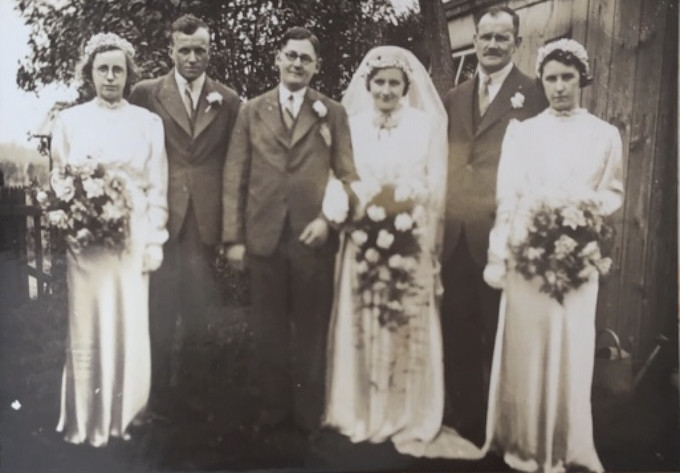
Wedding of Raymond Fuller Neave & Evelyn Martha M Dove at Great Ellingham. March 1938. Courtesy Carol Ewin
They married at the Methodist Church in 1938. A report of their wedding appeared in the Eastern Daily Press of Saturday 26th March, 1938:
“NEAVE— DOVE The wedding took place at the Methodist Chapel, Great Ellingham, on Wednesday, of Mr. Raymond Fuller Neave, only son of Mr. and Mrs. H. J. Neave, of The Stores, Great Ellingham, to Miss Evelyn Martha Mary Dove, only daughter of Mr. and Mrs. W. Dove, of Penhill Farm, Great Ellingham.
The Rev. William Howard (Wymondham) and the Rev. P. C. Cadamy (Attleborough) officiated. Mrs. W. Dye was at the organ. The hymns were “Gracious Spirit” and “0 Perfect Love“.
The bride, who was given away by her father, wore a gown of white satin, with veil, and a coronet of orange blossom and white satin shoes. She carried a shower bouquet of white carnations and trailing fern.
The bridesmaids, Miss Mary Pollard and Miss Jean Lingwood (bridegroom’s niece) wore dresses of pale blue satin beaute and headdresses of blue velvet flowers and blue satin shoes. Their necklaces were the gifts of bride groom. Each carried a bouquet of tea rose and mirilla tulips and fern.
Mr. Horace Dove (bride’s brother) was best man. A reception was held at Penhill Farm.
The presents numbered over 100 and included an oak hall stand from the friends of the Methodist Chapel and Sunday School, Great Ellingham, where the bride and bridegroom have been teachers for several years.”
1939 Register
The following year, the 1939 Register (providing a snapshot of the civilian population of England and Wales just after the outbreak of the Second World War), lists retired grocer 66 year old Herbert J Neave with his wife Mary A M Neave with three other persons living in The Street, Great Ellingham.
Now at the ‘Supply Stores’ is 27 year old Raymond F Neave with his 22 year old wife, Evelyn M M Neave (Evelyn would be 23 the following month).
I think it more than likely that Raymond (or, ‘Ray’ as I believe he was called) and Evelyn are living on the shop premises and Raymond’s parents, Joe and Mary Neave, are living in the house along with three other occupiers. Unfortunately, the details of these occupiers are redacted from the 1939 Register schedule.
Not long after the marriage, Ray with his wife ‘moved back’ to the Baptist Church.
With the 1939 Register referring to Joe Neave as a ‘retired grocer’, it is clear that he had handed over the running of the shop to Ray and Evelyn. However, Joe Neave had likely taken a ‘step back’ from the business over a few years. Having said that, Kelly’s Directory of 1937 lists ‘H.J. Neave’ as a grocer in Great Ellingham and not his son.
The shop retained the name ‘H.J. Neave & Son’.

Bill Heading H. J. Neave & Son from 1954. Courtesy of Lucinda Bell-Tye
1942
The Great Ellingham Invasion Committee Records of 1942 lists ‘Mr J Neave aged 69, Mrs M Neave 63, Mr R Neave and Mrs E Neave in Church Street.
Joe and Mary have been given ‘Food Distribution’ duties with both Ray and Evelyn part of the ‘Casualty Service’.
Baptist Church
After his marriage to Evelyn, Raymond Neave moved back to the Baptist Church. He also became involved in preaching. He often took services due to Pastor J E Davies ill-health.
In the late 1940s, Raymond became a Minister’s Assistant to Pastor George Yaxley. In 1954, Raymond Neave took up the pastorate at Great Ellingham.
Death of Mary Neave
After 46 years of marriage, Joe Neave buried his 77 year old wife Mary in the churchyard at St James’s Church, Great Ellingham on the 28th December 1956.
I have no doubt that the burial took place following a service at the Baptist Church which was conducted by Joe and Mary’s son, the Pastor Raymond Neave.
At the time of Mary’s death, the couple were living at ‘Church View’ in Church Street, Great Ellingham.
Death of Joe Neave
Just two years later, Herbert Joseph Neave (known as Joe) of Church Street, Great Ellingham died on the 23rd November, 1958. He was 85.
He too was buried in the churchyard of St James following a service at the Baptist Church.
Raymond inherits his Father’s Premises
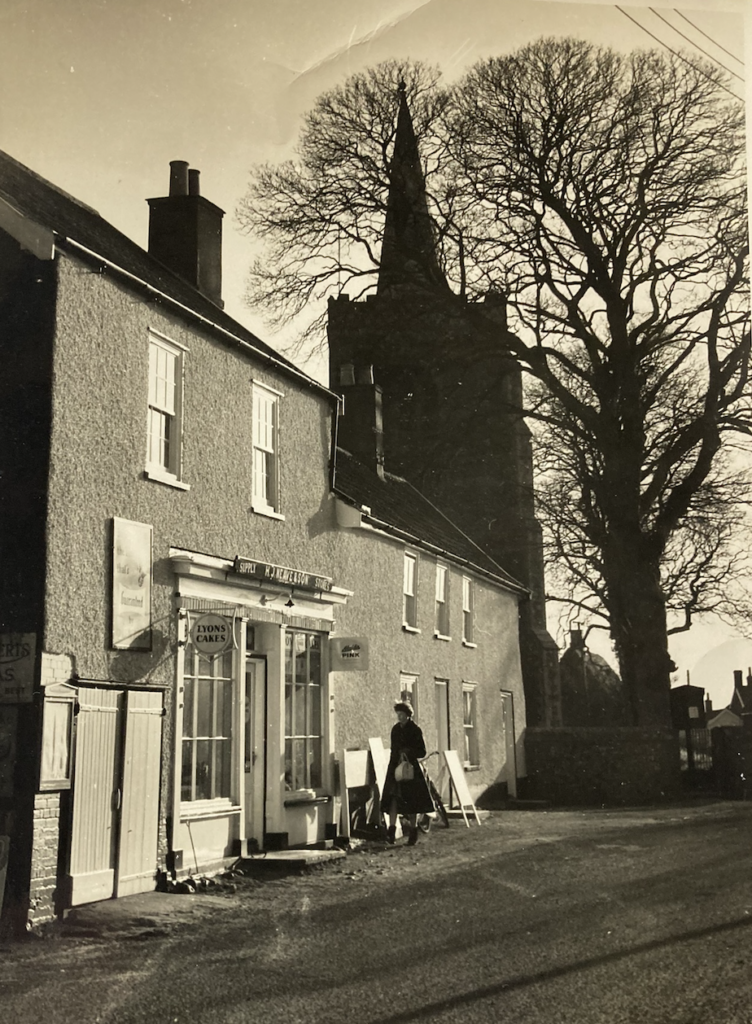
H J Neave & Son Supply Stores, Church Street. Date unknown. Courtesy Cindy & David Dove
Although Ray Neave had taken over his father’s business some twenty years earlier, it was not until his father’s death that Ray became the owner of the premises.
On the 29th April, 1959, Ray and his sister Mary as the executors of their late father, assented the late Joe Neave’s premises to Ray. The Assent describes the premises as:
‘All that dwelling house and shop with warehouse and outbuildings thereto belonging and situate fronting Church Street in the Parish of Great Ellingham ….. which said property is now in the occupation of the said Raymond Fuller Neave and is for the purposes of identification only delineated on the map or plan drawn hereon and is thereon edged with the colour red ..’
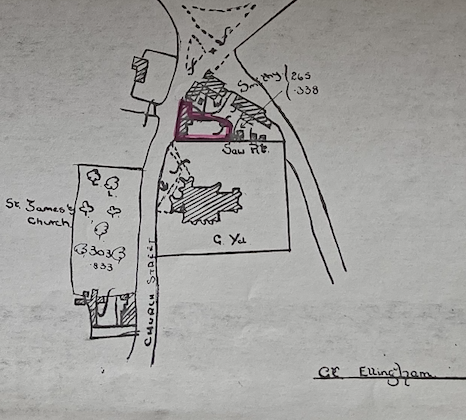
Plan to the Assent Deed dated 29th April 1959. Courtesy Adrian & Sue Carlton
The above plan to the 1959 Assent Deed clearly shows the extent of the premises which Ray Neave inherited from his late father. It is the very same premises which Joe Neave had purchased from the executors of George Henry de la Cour in 1920.
At 47, Ray Neave continued to run the Supply Stores with his wife. They had no children. However Ray continued his work in the Baptist Church which, no doubt, had increased since he became Pastor in 1954.
Move to Tring
The story goes that in 1961 Raymond Neave was offered the pastorate at New Mill Baptist Church in Tring, Hertfordshire. However, he had to find a buyer for his business.
After some 18 months of searching, a buyer was found.
The Diss Express of 31st August, 1962, reported that:
‘The Rev. Raymond Neave, pastor of Great Ellingham Baptist Church for the past eight years, is to take up a new post, at New Mill Baptist church Tring, on October 7.'
A coach load from the Baptist Church in Great Ellingham travelled to Tring for Ray Neave’s induction service on the 29th September, 1962.
Move back to Great Ellingham
After around 15 years in Tring, and having reached 65, Ray Neave decided to retire. He and Evelyn returned to Great Ellingham.
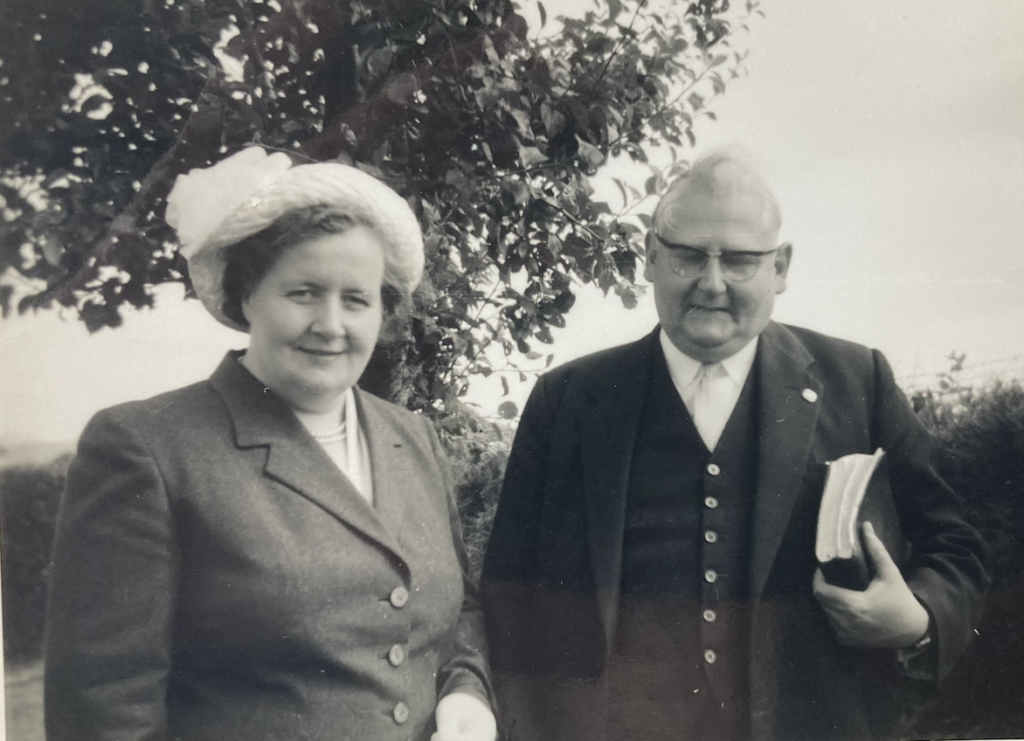
Evelyn & Raymond Neave. Courtesy Cindy & David Dove
Thomas Bradley – New Owner of the Supply Stores & House
Just prior to his move to Tring, on the 3rd September, 1962, Raymond Neave completed the sale of his shop premises and dwelling house.
Perhaps it was a ‘bitter-sweet’ day for Ray. Whilst no doubt he was looking forward to his new appointment in Tring, he would be leaving the shop and house which had been occupied by his father (and then himself) for over 60 years. Indeed, Ray had been born there!
The Supply Stores was purchased by Thomas Albert Bradley of Orpington, Kent. For the sum of £3,500, Bradley purchased the dwelling house , shop, warehouse and outbuildings in Church Street from Ray Neave. The plan attached to the Conveyance Deed of the 3rd September, 1962, clearly shows the extent of the premises purchased by Bradley. Again, this is the very same premises which Joe Neave had purchased from de la Cour’s executors in 1920.
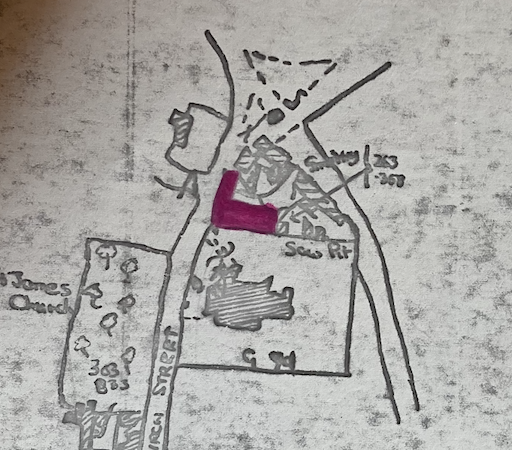
Plan to the Conveyance Deed of 3rd September 1962 between R F Neave & T A Bradley. Courtesy Adrian & Sue Carlton
The red colouring on the above extract from the 1962 Conveyance Deed identifies the shop, dwellinghouse, warehouses and outbuildings which Thomas Bradley purchased from Ray Neave.
Ray Neave agreed with Thomas Bradley that £2,000 of the purchase price (of £3,500) could remain owing to him. This was secured on the property by way of a mortgage for the principal sum plus interest at 6%. Accordingly, simultaneous with the purchase, Bradley entered into a mortgage with Ray Neave.
I have no doubt that in addition to purchasing the premises, Thomas Bradley also purchased the stock and trade of the Supply Stores. However, I have not seen any paperwork concerning an assignment of the goodwill of the shop and the stock. Nevertheless, I believe that Thomas Bradley continued to trade as a grocer from the premises.
On the 25th November, 1963, Bradley borrowed a further sum of £600 from Ray Neave. This sum too (with interest) was secured against the Church Street shop, house and premises.
However, Thomas Bradley’s tenure at the Supply Stores was short-lived.
Bradley sells to Burnett
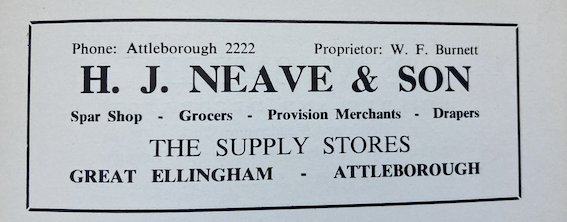
From Wayland Rural District Norfolk Official Guide c.1968
Courtesy R & J McDouall
On the 3rd June 1964, Thomas Bradley of The Stores, Church Street, Great Ellingham sold his business and premises to William Frank Burnett of Westcliff-on-Sea, Essex.
Burnett paid the sum of £3,000 for:
All that freehold dwelling house with shop with the warehouse and outbuildings therefore belonging situate fronting to Church Street....
He also paid the sum of £2,000 for ‘’the business of Grocer and General Storekeeper carried on by the Vendor [Bradley] on the said premises” as well as the goodwill of the business.
Bradley also covenanted (promised) not to carry on the business of a grocer and general storekeeper within a radius of 5 miles of the premises.
At the same time, Thomas Bradley settled his outstanding mortgage debt to Ray Neave. However, Bradley then became a lender to Burnett.
Simultaneous with his purchase, William Burnett entered into a mortgage deed with Thomas Bradley to secure £4,000 plus interest at 7% on the premises.
As far as I know, William Burnett remained trading at the shop for nearly 10 years.
Separation of Premises
In 1973, William Burnett sold the entire premises as well as the goodwill of the shop, to Ian and Anne Arundel. The Arundels owned the other shop in Church Street known as ‘Ye Olde Thatche Shoppe’.
It was during the time that Arundel’s owned the premises that the shop and the dwelling house became separated. Indeed, the dwelling house itself was also divided – at least on paper as it may have always been separate!
Southern end of the House
In 1974, the Arundels sold the far southern end of the dwellinghouse (the part nearest the churchyard). This part of the house was in disrepair.
Although originally part of the main house, this property (with its own front door) comprised just a ‘room’ with a small fireplace. It also had a fairly large attic space (without windows) which encroached over into the main house. This may well have been used as a sleeping area or bedroom.
Known then as ‘3 Church Street’ it likely had not been occupied for many, many years.
It is more than possible that at least in the 19th century, the owners of the dwellinghouse and shop let this end of the dwelling to tenants.
This ‘property’ was much later converted to a garage for the main house. This conversion also entailed incorporating a small piece of the churchyard with the reconstruction of part of the wall to the churchyard in the garage wall.
Separation of House and Shop
In 1975, the main house was also sold off leaving the shop separated (and in different ownership) from the dwelling house.
The shop and dwelling house had been in the same ownership from at least the turn of the 19th century.

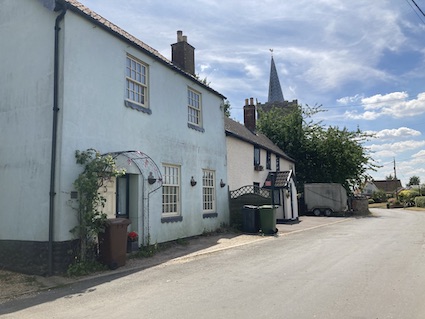
Left: Joe Neave’s Shop & House in Church Street.Possibly early 1900s.
Right: The former Shop and House. Photograph taken July 2022
Sources:
1799-1842 F W Horner, Records of the Surveyors to Commissioners for Inclosure in Parishes in Norfolk and Suffolk. Great Ellingham (Act 1799). Norfolk Record Office. Catalogue Ref: NRO, BR 90/2
1800 Inclosure Commissioner’s Particulars and Valuation, Great Ellingham. Norfolk Record Office. Catalogue Ref: NRO, MC 2213/119
Great Ellingham Parish Registers. Norfolk Record Office PD/609. Also available via www.ancestry.co.uk and www.familysearch.org
1881 census RG11/1956/75
1891 census RG12/1552/83
1901 census RG13/1851/11; RG/1867/80
1911 census RG14/11473/135
1921 census RG15. Registration District 231. Great Ellingham Sch 25. Also index only searched. www.findmypast.co.uk
GRO Index. Also available via FreeBMD website.
1895 June Qtr. Marriage. Neave, Herbert Joseph. Rolfe, Florence. Thetford 4b 667. https://www.freebmd.org.uk/cgi/information.pl?cite=C2Xv3pZ1BmH8QIAQwyQS9w&scan=1
1910 Dec Qtr. Marriage. Neave, Herbert J. Higgins, Mary A M. Wayland 4b 709. https://www.freebmd.org.uk/cgi/information.pl?cite=sramxS3qJXVy%2F5YUgc5EsA&scan=1
Norfolk News 3rd July 1875
Norfolk Chronicle 4th March 1876.
Downham Market Gazette 8th December 1900
Downham Market Gazette 19th January 1901
Eastern Daily Press 26th March 1938
Diss Express 31st August 1962
Newspapers viewed via British Newspaper Archive
The Story of 300 years of the Baptist Church at Great Ellingham – David Bugden
1939 England &Wales Register. The National Archives; Kew, London, England; 1939 Register; Reference: Rg 101/6590h. Ancestry.com. 1939 England and Wales Register [database on-line]. Lehi, UT, USA: Ancestry.com Operations, Inc., 2018.
1942 Great Ellingham Invasion Committee Record. Sue Fay
England & Wales, National Probate Calendar (Index of Wills and Administrations) 1858 to 1995, Herbert Joseph Neave. Died 23 Nov 1958. Norwich. Principal Probate Registry. Calendar of the Grants of Probate and Letters of Administration made in the Probate Registries of the High Court of Justice in England. London. Ancestry.com. England & Wales, National Probate Calendar (Index of Wills and Administrations), 1858-1995 [database on-line]. Provo, UT, USA: Ancestry.com Operations, Inc., 2010.
Historical deeds to cottage in Church Street. Thanks to Christine Fuller
Historical deeds to house in Church Street with additional information. Thanks to Adrian & Sue Carlton